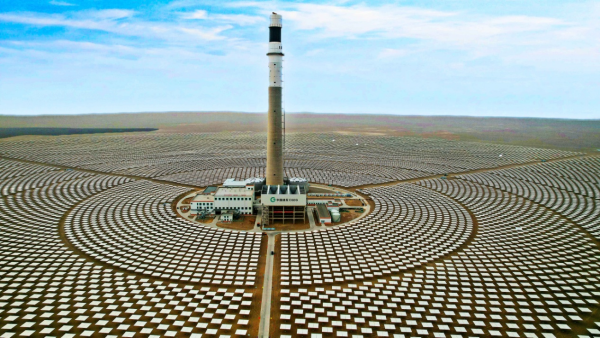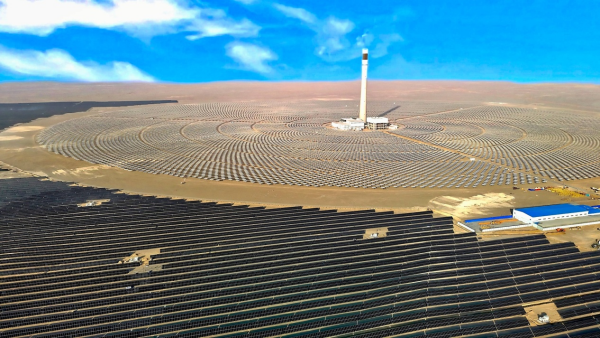The 100-megawatt solar thermal project at Jinta multi-energy complementary base, developed by China Green Development Investment Group (CGDG), was successfully connected to the power grid on May 28.

A view of the Jinta multi-energy complementary base [Photo/sasac.gov.cn]
Located in Jinta County, Gansu Province, the project is the first national-level “desert, Gobi, and barren land” mega base of its kind in the region to enter full operation. Once fully operational, the base is expected to supply an average of 1.45 billion kilowatt-hours of clean electricity annually, saving approximately 480,000 tons of standard coal and cutting carbon dioxide emissions by around 1.36 million tons each year.
Set in the heart of the Gobi desert, the project faces extreme climate conditions. Surface temperatures soar to 50°C during the day and plunge to -20°C at night.
Zhao Bin, head of the Jinta project, explained that the facility utilizes advanced tower-type molten salt thermal storage technology, integrating solar collection, heat storage, and heat exchange systems.
“It is built to withstand high altitudes and extreme cold, supported by intelligent algorithms and fully localized core equipment,” Zhao said.
Zhou Hui, project manager at Cosin Solar Technology Co., Ltd., noted that the solar thermal mirror field spans about 770,000 square meters. Cosin Solar independently developed the heliostats and field control system, addressing key challenges such as long-distance high-precision tracking and intelligent operation of large-scale mirror fields.
The project features a 10,000-cubic-meter thermal storage system with an energy storage capacity of 800MWhe. Its cold salt tank adopts a proprietary low-position design with short-axis pumps, increasing usable molten salt from 85 percent to 90.3 percent. This innovation reduces manufacturing complexity, improves pump reliability and maintainability, and lowers operating costs. The technology has been patented in China and several other countries.

The Jinta multi-energy complementary base features a 10,000-cubic-meter thermal storage system with an energy storage capacity of 800MWhe. [Photo/sasac.gov.cn]
Beyond its technological achievements, the project demonstrates a commitment to ecological restoration. The team has planted native species such as poplars and desert willows, along with economic crops such as apricot and peach trees. These efforts, combined with irrigation and soil improvement systems, have restored parts of the fragile desert ecosystem, delivering both ecological and economic value.
The successful grid connection of the Jinta project marks a milestone in China’s clean energy development. It stands as a vivid example of innovation driving sustainability and of human perseverance transforming barren landscapes into sources of green power.
(Executive editor: Yuan Ting)